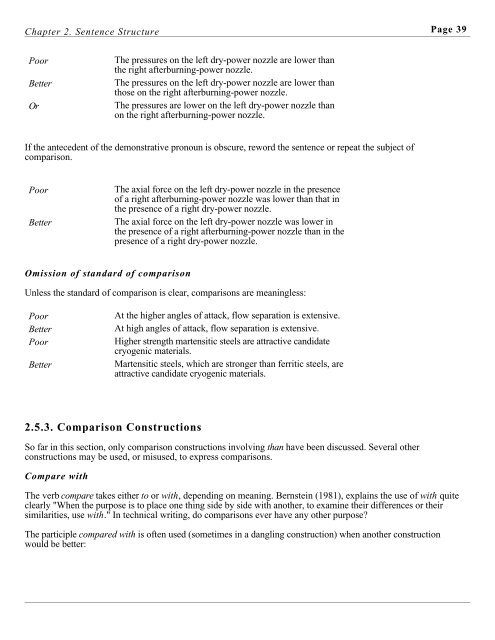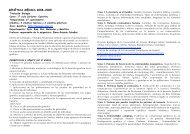Grammar, Punctuation and Capitalization - Handbook for Technical ...
Grammar, Punctuation and Capitalization - Handbook for Technical ...
Grammar, Punctuation and Capitalization - Handbook for Technical ...
Create successful ePaper yourself
Turn your PDF publications into a flip-book with our unique Google optimized e-Paper software.
Chapter 2. Sentence Structure Page 39PoorBetterOrThe pressures on the left dry-power nozzle are lower thanthe right afterburning-power nozzle.The pressures on the left dry-power nozzle are lower thanthose on the right afterburning-power nozzle.The pressures are lower on the left dry-power nozzle thanon the right afterburning-power nozzle.If the antecedent of the demonstrative pronoun is obscure, reword the sentence or repeat the subject ofcomparison.PoorBetterThe axial <strong>for</strong>ce on the left dry-power nozzle in the presenceof a right afterburning-power nozzle was lower than that inthe presence of a right dry-power nozzle.The axial <strong>for</strong>ce on the left dry-power nozzle was lower inthe presence of a right afterburning-power nozzle than in thepresence of a right dry-power nozzle.Omission of st<strong>and</strong>ard of comparisonUnless the st<strong>and</strong>ard of comparison is clear, comparisons are meaningless:PoorBetterPoorBetterAt the higher angles of attack, flow separation is extensive.At high angles of attack, flow separation is extensive.Higher strength martensitic steels are attractive c<strong>and</strong>idatecryogenic materials.Martensitic steels, which are stronger than ferritic steels, areattractive c<strong>and</strong>idate cryogenic materials.2.5.3. Comparison ConstructionsSo far in this section, only comparison constructions involving than have been discussed. Several otherconstructions may be used, or misused, to express comparisons.Compare withThe verb compare takes either to or with, depending on meaning. Bernstein (1981), explains the use of with quiteclearly "When the purpose is to place one thing side by side with another, to examine their differences or theirsimilarities, use with." In technical writing, do comparisons ever have any other purpose?The participle compared with is often used (sometimes in a dangling construction) when another constructionwould be better:






